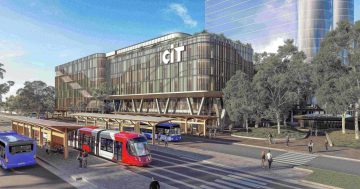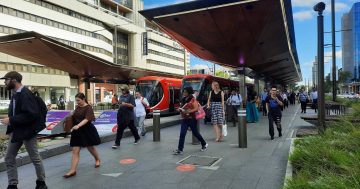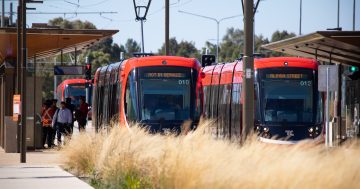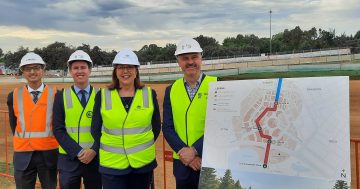
Construction of light rail Stage 2 may not have even started but the government is preparing for the rest of the envisaged network. Photo: File.
Further stages of light rail will include an east-west link from Belconnen to the Canberra Airport, and continuing the already planned line to Woden further to Tuggeranong, the ACT Government’s $14 billion Infrastructure Plan has confirmed.
The plan, launched today by Chief Minister Andrew Barr, outlines already announced projects such as the $500 million Canberra Hospital expansion, Stage 2 of light rail to Commonwealth Park and Woden, and a new Canberra Theatre, but it also takes a longer-term view of what the ACT requires to service a population of half a million people.
It looks at projects to be considered over the next five years and beyond, including developing the light rail network, duplicating major roads, extending cycling paths and lanes, expanding northside hospital services, new schools and works to support more residential land releases.
Mr Barr said the plan was all about health, education, housing and transport, but the building of the light rail network will likely be the most expensive project government will have to fund over the coming decades.
The plan says that with light rail Stage 2 to Woden up and running by the mid-2020s, Stage 3 would first connect Belconnen to the City and then extend to Canberra Airport via the Russell Defence precinct.
It says a line to Belconnen will link key facilities like Calvary Hospital, the University of Canberra, the Australian Institute of Sport and the Australian National University, and with 30,000 new residents at Ginninderry in the coming decades, it was the ‘natural choice’ for Stage 3.
Stage 4 to the Tuggeranong Town Centre will travel via Mawson, and will set off a new round of development along the line that the plan says will support local businesses and provide an economic boost for group centres in Mawson, Wanniassa and Kambah.
The ACT Government’s light rail master plan aims to deliver a new stage of light rail roughly every five years, and Mr Barr said the timeline for Stage 2 remained realistic.
He said Stage 2 was still on track to be running by 2024, and there were indications from the Prime Minister that the Commonwealth was ready to assist state and territory infrastructure projects, encouraging them to bring suitable projects forward.
“I don’t see the kind of political interference that was the case in 2016 repeating itself in the 2020s,” Mr Barr said.
He said the Stage 3 and 4 routes reflected a sensible approach to the progressive expansion of the light rail network as Canberra’s population moves beyond half a million people.
“People want to know that there is a long-term commitment to the light rail network and that we are doing the forward planning and thinking about future stages,” Mr Barr said.

The planned light rail network as set out in the Infrastructure Plan. Image: ACT Government.
Mr Barr said the government would be borrowing to pay for many of the projects but with interest rates at record lows “there has never been a lower cost of borrowing in global history, so it is a good time to be in the market for new infrastructure financing”.
Mr Barr said the Budget remained on track to return to surplus over the forward estimates.
Already budgeted items include the Surgical Procedures, Interventional Radiology and Emergency (SPIRE) project which aims to future-proof Canberra Hospital, but long term the government is looking at beefing up services in the north to meet demand from a growing population.
This could mean upgrading and expanding the existing public hospital facilities on the northside and/or delivering a new hospital.
In the city, the government is prioritising redeveloping Canberra Theatre, which was built when the ACT’s population was only 80,000, and repurposing it with a flexible flat floor to seat about 2000 people at a cost of $100-250 million.
“Our preferred order for new infrastructure of that social and cultural kind is the Theatre Precinct first, the stadium second and a convention centre third,” Mr Barr said.
The only thing that would change that order would be a funding partner coming forward with a viable offer, he said
Longer-term, the government is looking at a 7500 seat enclosed arena, either as part of a new stadium, convention centre or a stand-alone facility.
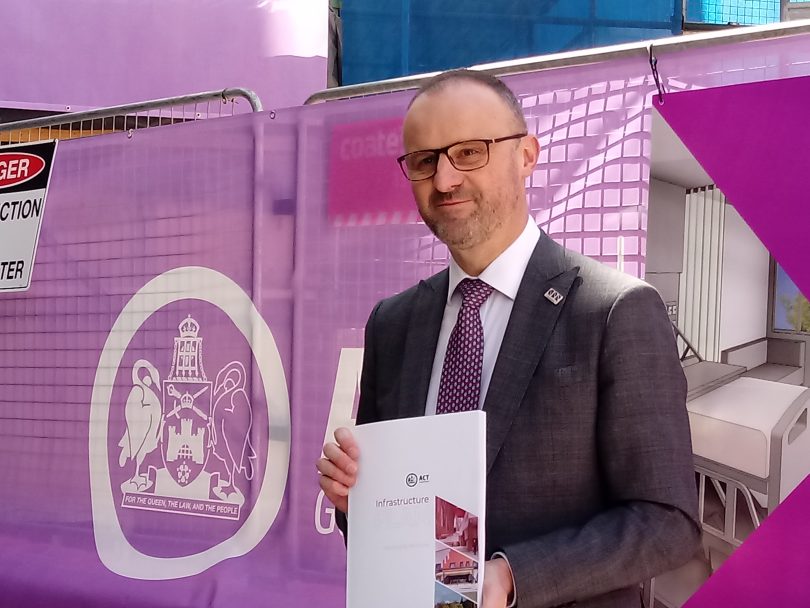
Chief Minister Andrew Barr at the Canberra Hospital before launching the ACT Government’s Infrastructure Plan. Photo: Ian Bushnell
The convention centre remains on the government’s wishlist with land set aside, but it will only go ahead with private sector and Commonwealth support. Without that, the current facility will need to be upgraded.
The plan outlines works to support the ongoing development of new suburbs in Gungahlin and the Molonglo Valley, including new schools, but also new housing in central Canberra on the Acton Waterfront in West Basin, and in the former industrial area of East Lake in Kingston.
It says the first land releases for East Lake are expected in 2022-23, with more to come over the following decade.
The plan also points to the CSIRO-owned, 700-hectare Ginninderra Experiment Station in Belconnen as a prospect for future residential housing.
Over the next five years, the government will also spend $600 million on public housing to replace and upgrade 1000 existing homes and build a further 200 new dwellings, funded directly with $100 million through the Budget and $500 million from the sale of aged homes no longer fit for purpose.
In education, apart from new schools and college modernisations, the big-ticket item is building a new CIT to replace the Reid campus, with Woden a mooted site, at a cost of $100-250 million.
The government continues to work with UNSW on its plans for a new campus for 6,000 students in the city on Constitution Avenue that would create a Defence and Security Innovation Precinct.
Mr Barr said the government would certainly be taking the plan’s contents to next year’s election but denied it was a political document, saying many of the proposals were above politics.












